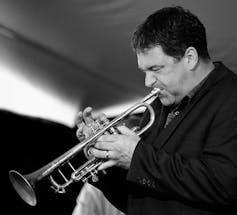Tired of all the news about COVID-19? Why not take your ears on holiday with a summer listening playlist, assembled by music faculty from Carleton University.
If you’re tired of the old playlists yet are likewise dissatisfied with sound-alikes suggested by YouTube and Spotify, we’ve curated some “hidden gems” — lesser-known music that in our estimation deserves more attention.
Our selections represent a variety of genres, often cutting across traditional boundaries, however all of them are worthy of further listening for their musicality as well as for what they say and mean. Many factors contribute to how we can think about “hidden gems,” but here are three:
-
The sheer availability of music. It’s true that the quantity of available music is greater than ever before. At the same time, the percentage of available music known by the greater public has always been quite small. (To the people of Italy, Beethoven was a “hidden gem” in his day).
-
Exclusionary practices of the music industry, which have meant that contributions by women and Black, Indigenous or racialized composers, among others, have been marginalized.
-
Serendipity. For example, a talented composer or songwriter may die or disappear after a promising start to their career, like Guillaume Lekeu or Jill Janus.
Join us on a voyage of discovery!
Made-in-Canada up-tempo bebop

‘The Romance of Improvisation in Canada: The Genius of Eldon Rathburn’ features Kevin Turcotte on trumpet. (Flickr/Matt Jiggins), CC BY-SA
If you like mid-century up-tempo bebop in the Miles Davis or Charlie Parker vein, you should listen to “The Romance of Improvisation in Canada.” It’s the title track from a recent album featuring arrangements of jazz-inspired film music by Canadian composer Eldon Rathburn (1916-2008).
Rathburn wrote more than 250 film scores, most of them during a 30-year career as a staff composer for the National Film Board.
Arguably Canada’s most prolific composer of film music, Rathburn was a musical polyglot. He experimented with a wide range of styles and showed diverse influences ranging from classical, country, blues, electronic, avant-garde, church and dance music, to popular music and jazz.
– James Wright, music theorist and composer
Solo piano: William Duckworth
If you like solo piano music by Philip Glass and Max Richter, then try The Time Curve Preludes by William Duckworth. Written in 1977-78, this collection of 24 short piano pieces was one of the first compositions to show how the harder-edged minimalism of the 1960s and 1970s could be combined with a more intimate, expressive style.
William Duckworth’s ‘The Time Curve Preludes - No. 1.’
Apart from the echoes of minimalism, these pieces also often appeal to fans of drone music, Indian classical music, medieval music and jazz, because of the many references to these styles woven into the texture. A good overview of the piece is available from Lovely Music.
– William Echard, musicologist
If you like Gershwin: Dana Suesse
Dana Suesse (1909-87) composed one song that virtually every movie buff should know: “You Oughta Be in Pictures” (1934) served as the first unofficial anthem for Hollywood. Suesse composed it when she was being promoted by the prolific composer George Gershwin.
A facile song-writer in the style of Tin Pan Alley, Suesse nevertheless wanted to write symphonic music in the manner of her friend Gershwin. After writing large-scale works like “Concerto in Three Rhythms” (1932) and “Concerto for Two Pianos” (1943), she spent three years (1946-49) in Paris studying “serious” composition with world-renowned teacher Nadia Boulanger.
‘Jazz Nocturne,’ by Dana Suesse.
If you like Gershwin’s “Rhapsody in Blue,” then you should try Suesse’s “Jazz Nocturne,” where she renders the classical tradition of the Nocturne in a jazzy idiom for piano. After a mysterious opening, we get a lively swing à la Gershwin. The slower, emotional heart of the piece takes up the latter half, later set to words as the hit song “My Silent Love.”
– James Deaville, musicologist
Choral work by Andrew Balfour
If you like uplifting works for choir and orchestra like the “Ode to Joy” from Beethoven’s Ninth Symphony, you might like “Mamachimowin” (the act of singing praises) by Andrew Balfour, a composer of Cree descent.
‘Mamachimowin’ by Andrew Balfour, performed by the Toronto Mendelssohn Choir and Toronto Symphony Orchestra.
Balfour, who is founding director of Winnipeg’s Camerata Nova choir, is steeped in the choral music tradition. The text translates Psalm 67 into Cree and the music flows from whispered text to sonorous string accompaniment to full-throated song.
As the composer notes, this moving piece “explores the difficult relationship between Indigenous spirituality and the impact of the Christian culture on First Nations People.” “Mamachimowin” was commissioned by the Toronto Mendelssohn Choir in 2019 for its 125th anniversary.
– Ellen Waterman, professor and Helmut Kallmann Chair for Music in Canada
Lesser-known talents of Kevin Breit

Kevin Breit’s album ‘Stella Bella Strada.’ https://www.kevinbreit.com/new-release
Canadian musician Kevin Breit is widely known for his remarkable skills as a guitarist, and has performed and recorded with musical luminaries including k.d. lang, Cassandra Wilson and Norah Jones.
Perhaps lesser known, but no less remarkable, are his abilities as a songwriter. Take, for example, his song “Prairie Widow Waiting by the Front Door” from his 2005 recording Burnt Bulb on Broadway, a collection of Breit-penned songs performed by multiple vocalists.
Beautifully sung by Gwen Swick (another Canadian musician deserving wider recognition), “Prairie Widow” tells the poignant story of a farmer who died in the First World War, both from his perspective and that of his widow. The opening lines of the first and final verses (“There’s a murder of crows on the clothesline” versus “There’s a murder of Joes on the front line”) provide an evocative narrative frame for this moving song about love and loss.
– Jesse Stewart, professor and composer
Medieval complexity: ‘Le ray au soleyl’
If you like J.S. Bach, Steve Reich and crossword puzzles, you will love Johannes Ciconia’s minimalist “Le ray au soleyl.”
As far as medieval gems go, this one positively sparkles with rhythmic complexity.
The text speaks of a sweet turtledove and a ray of sunlight, themes evoking the dove-in-sun paraheraldic badge of Duke Gian Galeazzo Visconti of Milan.
“Le ray au soleyl” is a “round” with only one notated voice. The other two voices are derived from the first and performed at different rhythmic rates. This is what’s known as a “prolation or proportion canon.” But to figure out the proportions, you have to solve a Latin riddle. Sudoku of the Middle Ages! A prolation gem.
The performance of “Le ray au soleyl” by Ensemble Project Ars Nova gradually adds each voice so that you can appreciate how it is built.
– Alexis Luko, associate professor of musicology



 How Marvel’s Fantastic Four discovered the human in the superhuman
How Marvel’s Fantastic Four discovered the human in the superhuman  Trump Signals He May Influence Netflix–Warner Bros Merger Decision
Trump Signals He May Influence Netflix–Warner Bros Merger Decision  Trump to Pardon Reality Stars Todd and Julie Chrisley After Tax Fraud Conviction
Trump to Pardon Reality Stars Todd and Julie Chrisley After Tax Fraud Conviction  Pulp are back and more wistfully Britpop than before
Pulp are back and more wistfully Britpop than before  Netflix’s Bid for Warner Bros Discovery Aims to Cut Streaming Costs and Reshape the Industry
Netflix’s Bid for Warner Bros Discovery Aims to Cut Streaming Costs and Reshape the Industry  FCC Chair Brendan Carr to Face Senate Oversight After Controversy Over Jimmy Kimmel Show
FCC Chair Brendan Carr to Face Senate Oversight After Controversy Over Jimmy Kimmel Show  Disney’s ABC Pulls Jimmy Kimmel Live! After Controversial Remarks on Charlie Kirk Killing
Disney’s ABC Pulls Jimmy Kimmel Live! After Controversial Remarks on Charlie Kirk Killing  6 simple questions to tell if a ‘finfluencer’ is more flash than cash
6 simple questions to tell if a ‘finfluencer’ is more flash than cash  Disney’s Streaming Growth Hinges on International Expansion and Local Content
Disney’s Streaming Growth Hinges on International Expansion and Local Content  Google and NBCUniversal Strike Multi-Year Deal to Keep NBC Shows on YouTube TV
Google and NBCUniversal Strike Multi-Year Deal to Keep NBC Shows on YouTube TV  Oscars 2025: who will likely win, who should win, and who barely deserves to be there
Oscars 2025: who will likely win, who should win, and who barely deserves to be there  Trump–Kushner Links Raise Concerns as Paramount Pushes $108B Warner Bros Discovery Bid
Trump–Kushner Links Raise Concerns as Paramount Pushes $108B Warner Bros Discovery Bid  Gulf Sovereign Funds Unite in Paramount–Skydance Bid for Warner Bros Discovery
Gulf Sovereign Funds Unite in Paramount–Skydance Bid for Warner Bros Discovery  Trump-Inspired Cantonese Opera Brings Laughter and Political Satire to Hong Kong
Trump-Inspired Cantonese Opera Brings Laughter and Political Satire to Hong Kong  FCC Chair Brendan Carr to Testify Before Senate Commerce Committee Amid Disney-ABC Controversy
FCC Chair Brendan Carr to Testify Before Senate Commerce Committee Amid Disney-ABC Controversy 































